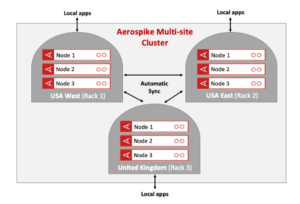
Aerospike Delivers Multi-Site Clustering in DB 5

(Timofeev Vladimir/Shutterstock)
Aerospike today announced support for multi-site clustering in version 5 of its eponymous NoSQL database, giving customers the capability to deploy a single database across multiple geographically dispersed data centers without compromising data consistency or availability.
Aerospike is in the process of carving a niche for itself in the database market that is centered on extreme performance and availability. Other databases may store bigger data (Apache Cassandra) or be more accessible to developers (MongoDB). But when it comes to delivering strong consistency for critical applications that demand low latencies Aerospike wants to be the only NoSQL database on the block, competing against the SQL giants that dominate the space, namely Oracle RAC and IBM Db2.
If Aerospike hasn’t met it already, it’s one step closer to achieving that goal with today’s launch of Aerospike Database 5, which delivers multi-site clustering in a single database image. Thanks to enhancements in its Cross Data Center Replication (XDR) technology, customers can run a single database cluster that spans North America, Europe, and Asia, without sacrificing high performance or data consistency guarantees. And unlike Oracle RAC or IBM’s enterprise Db2 systems (for z/OS or IBM i), Aerospike runs on commodity Intel hardware, allowing customers to place all (or just some) of their database in public clouds.
DB 5 builds upon the strong consistency guarantees that Aerospike introduced with the launch of DB 4 two years ago, according to Srini Srinivasan, Aerospike’s chief product officer and founder.
“Before we had multi-site clustering, what Aerospike supported was the ability to have multiple clusters, one cluster in each site, replicating in an asynchronous manner across these sites,” Srinivasan says. This setup will result in relaxed data consistency because it’s based on asynchronous replication, he says.
“When you distribute a single cluster with multi-site clustering across multiple sites, one does have to trade off a little bit higher write latency, because that depends on the distance between the sites,” he explains. “So now we support active-active deployments, both with multiple clusters communicating with each other asynchronously across sites, as well as now with multi-site clustering, a single cluster communicating synchronously across sites.”
Aerospike measured the latency across the United States and discovered that its multi-site clustering in DB 5 can achieve write latencies of between 100 milliseconds and 125 milliseconds. These systems were under full load, Srinivasan, and still delivered sub-millisecond read latencies on a local basis.
“We just trade off a higher write latency based on the distance between sites to preserve lower read latency with strong consistency, so you don’t lose a single record,” Srinivasan tells Datanami. “When there are failures in a multi-site system, with an entire site failing and not being available, these systems can continue with no operator intervention, with full-correctness and availability on the sites that are up. And when the failed site comes back online, the system will seamlessly be able to rejoin the cluster and go back to its original state with no operator intervention and virtually no service disruption.”
Such high levels of data availability and consistency are of critical importance for global, always-on businesses that can’t take a chance with data not being available, Srinivasan says. “They want local access to data in the geographies they’re in, but to not worry about the fact that the change happening in the local site do not appear immediately all over the world,” he continues. “This is especially important for a money-transfer system, which is where we have been.”
Aerospike has been winning contracts with banks that, in previous years, would have had no choice but to select a traditional relational database management system, such as Oracle, Db2, or Tandem NonStop systems. For example, the European Central Bank uses Aerospike to run TARGET Instant Payment Settlement (TIPS), which is the mechanism that allows payment service providers to offer fund transfers to their customers. Such a system cannot tolerate much, if any, downtime, so care must be taken in selecting the appropriate platform that underlies the application.
The ECB isn’t globally distributed. “But what we are announcing today is to be able to run these systems–one in the US, one in Europe, and one potentially in Asia–and have the same application service users across seas with a single global transaction system,” Srinivasan says.
Relational databases can fit the bill, but customers today are expressing a desire to move past the rigid schemas that come with relational databases. As a NoSQL system, Aerospike offers schema flexibility and support for JSON-like objects, which gives developers much more flexibility for modifying database systems without requiring a restart – something that is unheard of in the relational world.![]()
And because the sites running in a multi-site Aerospike cluster can be on-prem or in a public cloud, DB 5 bolsters customers’ ability to move data in a hybrid-cloud and multi-cloud setup, says Lenley Hensarling, chief strategy officer for Aerospike.
“We are working with companies that are looking at using us trans-continental situations and using us with an inter-cloud deployment, so one part of the cluster might be in Google and another might be in Amazon,” Hensarling says. “They look at this in the next step up in assurance and availability, where you’re not dependent on only cloud vendors if you’re operating completely in the cloud.”
It also gives Aerospike customers a bargaining chip as they negotiate with cloud platforms, he adds. “We’re finding out as people become more sophisticated about the risks and costs involved with going to the public cloud, they’re becoming a lot more sensitive to that,” Hensarling says.
The specific change that precipitated Aerospike’s entry into the multi-site clustering set was the continued evolution of the core algorithms that govern the movement of data, Srinivasan says. The company extended the algorithms to be able to work with racks that may be separated by thousands of miles.
For Aerospike, the work that went into DB 5 is the culmination of years’ worth of work to build a solid, high-performance database system that can challenge the relational incumbents.
“In some cases, we do replace systems in traditional areas, but we are also replacing other NoSQL systems,” Srinivasan says. “Because typically NoSQL–or non-relational systems is probably a better term–have allowed you to relax consistency in order to get the elasticity and geographical distributed features. And they provide some kind of scale, but they don’t provide strong consistency. We are combining the strong consistency, the data distribution, the elasticity, with the performance at scale that we bring to the table, which has been well established over 10 years.”
Aerospike is holding its Virtual Summit this week. For more information, see the company’s website.
Related Items:
Aerospike Adopts Cloud Native Standards with Cloud Offering
Aerospike Says Secret to NoSQL Speed is Simplicity
































